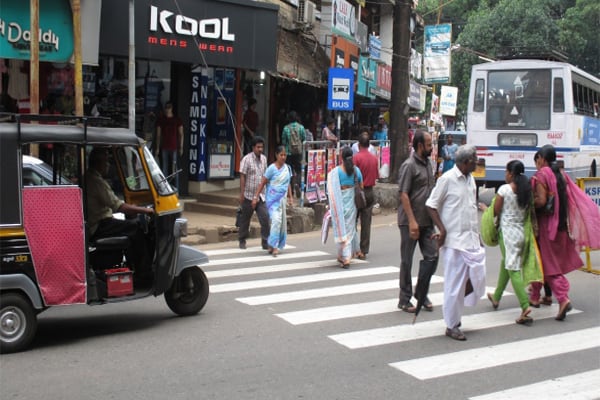
Over 4.4 billion people live in cities today, putting extreme pressure on energy and resource consumption. By 2050, 6.5 billion people¹ will be urban. Sustainable development cannot be achieved without significantly transforming the way we build and manage our urban spaces. Although cities occupy just 3 per cent of the available land, they account for 60-80 per cent of energy consumption and 75 per cent of carbon emissions. The transport sector alone causes over 23 per cent of the global greenhouse gas emissions². Every year 3.5 million people die prematurely due to pollution, one-fifth of which are reported from India³, write Naim Keruwala, Program Coordinator and Team Lead, City Investments To Innovate, Integrate and Sustain (CITIIS), the National Institute of Urban Affairs (NIUA) and Swapnil Saxena, Knowledge Officer, CITIIS, NIUA.

Swapnil Saxena, Knowledge Officer, CITIIS, NIUA
There is a growing international consensus towards action on sustainable transport that can lessen the strain on social, economic and environmental well-being of cities, while also promoting development. While there is no universal definition of sustainable transport, the High-Level Advisory Group on Sustainable Transport⁴, appointed by the UN Secretary-General in 2014 defines it as ‘the provision of services and infrastructure for the mobility of people and goods – advancing economic and social development to benefit today’s and future generations—in a manner that is safe, affordable, accessible, efficient, and resilient, while minimising carbon and other emissions and environmental impacts.
Transportation’s Crucial Role in Achieving the SDGs

Managing the transport sector can make a direct and indirect contribution towards the achievements of the Sustainable Development Goals (SDGs) if the three pillars of sustainable development – economic, social, and environmental – are integrated into transport policies, planning and operation. Mobility stands out as a key focus area for SDG 11 (Sustainable Cities and Communities) which promotes ‘cities and human settlements that are inclusive, resilient, safe and sustainable.’
SDG target 11.2 explicitly calls on the international community to work toward sustainable transport for all people by ‘providing access to safe, affordable, accessible and sustainable transport systems for all, improving road safety, notably by expanding public transport, with special attention to the needs of those in vulnerable situations, women, children, persons with disabilities and older persons.’ Four out of 169 SDGs are directly transport-related, while 15 are indirectly related to the transport sector. This shows that though transport does not have a dedicated SDG, it plays a critical role in enabling other SDGs and achieving growth and development. As an example, sustainable transport systems are necessary to provide access to education (SDG 4), food security (SDG 2), employment and empowerment for women (SDG 5), healthcare (SDG 3), and to curtail the global greenhouse gas emissions (SDG 13).

Accomplishing the SDGs will thus rely on advances in sustainable transport. As a member state, India is committed to the 2030 Agenda for Sustainable Development. With only ten years remaining to meet the set targets, now is the time for action to tackle the multiple challenges posed by the urban transport sector, such as congestion, air pollution, and traffic fatalities.

Safety of pedestrians is a major concern in most Indian cities
The Focus Areas for Sustainable Transport in India
Depleting Air Quality and Congestion
According to the 2019 World Air Quality Report,⁵ 17 Indian cities rank among the world’s 25 most polluted cities, a significant percentage of which is caused by vehicles, especially in the big cities. In addition, congestion on roads is a critical issue in India, not only has led to increased traffic incidents but also huge economic losses emerging from time and workforce losses. Bengaluru leads worldwide in traffic congestion, while Mumbai, Pune, and New Delhi are at the fourth, fifth, and eighth positions, respectively. Pollution and congestion, albeit critical, are manifestations of larger systemic issues in India’s transportation policy.
Deteriorating Road Safety
There is a huge proportion of India’s population, especially in Tier II cities that still depend on walking, cycling, or using informal modes of non-motorised transit for commuting. In most Indian cities, non-motorised modes share the same right of way as cars and twowheelers leading to unsafe conditions for all. The number of fatalities is also increasing in relation to the increasing motorisation and higher slow-moving vehicles in the traffic stream and is estimated to be at 2,30,000 deaths per year – half of which are reported to be vulnerable road users – motorcyclists, pedestrians and cyclists.
Policy and Institutional Barriers
Growth in polycentric metropolitan regions, commonly called the ‘sprawl’ continues to present a huge challenge for transportation planning in India. The most common solution to manage this challenge is through informal solutions that increase congestion and pollution and disproportionately affect the poor. This ‘last mile’ challenge is apparent globally but is acute in the case of India and can be attributed to a fragmented institutional structure and a federal decision-making system.
Urban transport systems require several functions to be performed in a wellcoordinated manner for a seamless and comfortable travel experience for commuters. Unfortunately, these are performed by multiple agencies under the central, state and city governments with different mandates. Various government agencies plan infrastructure as per their geographical mandate but fail to come together to provide end-to-end solutions to complete the transport loop. In addition, fragmentation or overlap of legislations poses challenges that constrain the ability to effectively manage the problems of urban transport. Firstly, it leads to incoherence in the policy framework and secondly, it reflects in the timing, coordination and treatment of how states and cities approach a particular problem.

India’s urban transport is shifting to sustainable modes of transport like electric vehicles
Fragmented Markets and Structural Barriers
Three key players in transportation planning include technological innovators, decisionmakers, and end-users. The interaction between the three owing to their conflicting visions acts as a major barrier for formulating policies and actions. While city planners try to reduce congestion, the manufacturers do the opposite by maximizing sales. Therefore, to achieve the common societal goal of promoting sustainable development necessary to balance the commercial interest of the manufacturing industry, the central government’s focus on infrastructure development, and the city governments’ need to enable to deal with local issues such as pollution and congestion.
Deficient comprehensive design standards
The lack of common standards for design, operation, and maintenance of transport infrastructure has caused unorganised and unregulated traffic across many Indian cities and is a major cause of the high occurrence of traffic accidents and fatalities. The Indian Road Congress (IRC) has been the nodal agency that sets design
guidelines and technical standards for the construction of roads and bridges, primarily for intercity roads but also for urban roads. These standards are voluntarily followed by all road construction agencies, including the Public Works Departments of cities. Since they are voluntary for municipalities or public works departments, their enforcement of the contractors is sacrificed.
Resource Barriers – human, institutional, and financial
Planning integrated transportation projects is a multi-stakeholder process. Unfortunately, the capability for undertaking a coordinated approach along with a holistic understanding of transport issues and their causes involved is generally lacking at the state government and city level. In addition, there is an imbalance and bias between funding and investments for autocentric road expansion projects and non-motorised and high-capacity public transport infrastructure. It is important that urban transport is treated as an integrated whole through systems financing and pricing.
Noteworthy Achievements
Despite several structural challenges, one cannot negate the incremental progress made in several aspects of transportation planning across levels of governance in India to push for specific solutions. Policies such as the Faster Adoption and Manufacturing of (Hybrid and) Electric Vehicles in India (FAME)⁶ which provide subsidies for EV production and charging infrastructure have made India a frontrunner in taking proactive steps to ensure healthier lifestyles and decrease greenhouse gas (GHG) emissions. India expects a 30 per cent share of Electric Vehicles (EVs) on the road by 2030.
The Ministry of Housing and Urban Affairs (MoHUA) through the Smart Cities Mission has put impetus to solutions like public transport and NMT, increasing the adoption of technological solutions for transport integration, using BRTS, and construction of walking and cycling tracks.
The ‘Streets for People’ initiative aims to create flagship walking initiatives in cities, which focus on placemaking and liveability. By reimagining streets as public spaces through the lens of economic regeneration, safety, and child-friendly interventions initiatives, cities are working to ensure a green recovery from COVID-19. A similar initiative called ‘Cycles4Change’ is enabling cities to implement low-cost interventions like pop-up lanes, traffic-calmed streets, community cycle rental schemes, and cycle-training programs, thus fostering a long-term social and behavioural change in the perception of mobility.
Also, a noteworthy urban project that deserves mention is the Rejuvenation of Auto Rickshaws in Amritsar through Holistic Interventions (project RAAHI)⁷ by replacing 7,000 diesel-run autorickshaws with e-autos, the largest formalisation activity of such nature in India. Financed under the CITIIS⁸ program, and currently under implementation, the project adopts an integrated approach and aims to achieve mobility-related, socioeconomic, environmental, and institutional reforms.
Way Forward
Achieving sustainable transport will need a broad coalition of stakeholders—from industry, policy, and research institutes, local and national governments, and sector organisations—to engage and address challenges in a holistic manner, at a scale commensurate with the size of the challenges.
Integrated policymaking is critical to decision-making on transport systems and infrastructure. It is essential that financial resources be channeled into training and capacity building of the concerned personnel in order to empower them to take on the complex challenges of the urban transportation sector.

E-rickshaws provide eco-friendly means of last-mile connectivity
Importance should be given to reinforcing efforts towards preventing road traffic fatalities, which include ensuring minimum safety standards for vehicles at the national level, and through commuter awareness at the local level. The SDG target of reducing global road traffic deaths and injuries by 50 per cent by 2020 can be used as a guide for this. Higher quality vehicle design, infrastructure, driver training, information, and many other factors contribute to a more equitable system, and, in this way, accessibility is a key element in ensuring the social sustainability of the transport sector.
Technology advancing clean fuels and clean energy is a high priority, and when considering the scale of the health and climate challenges, it is imperative.
Implementation of all the above suggestions calls for strong supporting institutional and governance structures, political will, sound leadership, transparency, and adequate resources. The focus on long-term sustainability can be strengthened by creating an effective network of cities for crosslearning and knowledge sharing. It is equally important that any solutions generated are analysed for scalability and transferability potential. Wherever feasible, they should be implemented in other cities.
1. https://www1.undp.org/content/oslo-governance-centre/en/home/sustainable-development-goals/goal-11-sustainable-cities-and-communities.html
2. https://sustainabledevelopment.un.org/content/documents/2375Mobilizing%20Sustainable%20Transport.pdf
3. https://www.cseindia.org/air-pollution-is-now-the-fifth-largest-killer-in-india-says-newly-released-findings-of-global-burden-of-disease-report–4831
4. https://unfccc.int/news/new-un-high-level-advisory-group-on-sustainable-transport
5. https://www.iqair.com/world-most-polluted-cities/world-air-quality-report-2019 en.pdf&sa=D&source=editors&ust=1625057990436000 &usg= AOvVaw0tuPok3Inmr6UgLFv43yHS
6. https://pib.gov.in/PressReleasePage.aspx?PRID=1577880
7. https://www.niua.org/citiis/project/development-sustainable-and-green-public-transportation-amritsar-city
8. https://www.niua.org/citiis/
Be a part of Elets Collaborative Initiatives. Join Us for Upcoming Events and explore business opportunities. Like us on Facebook , connect with us on LinkedIn and follow us on Twitter, Instagram.











